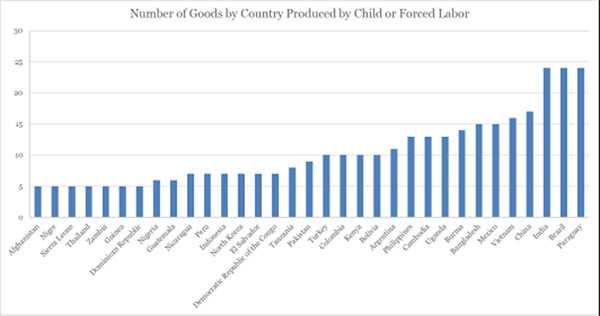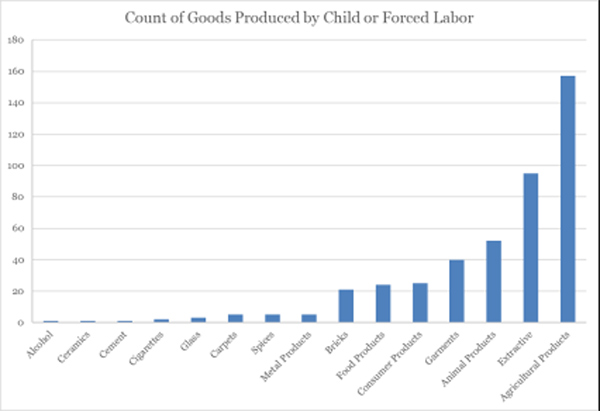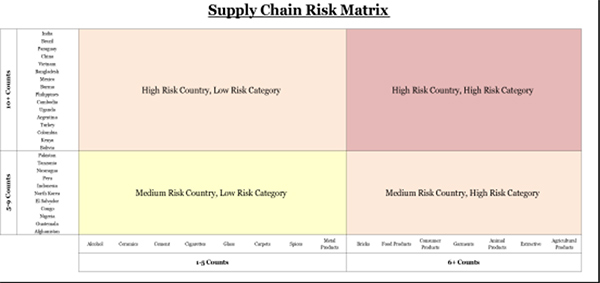A New Year for Human Rights Compliance Resolutions

Originally published in IndustryToday on February 4, 2022. Reprinted with permission.
The new year already is here and, if past is prologue, nearly two-thirds of resolutions have by now been abandoned. If you are responsible for solidifying the “S” in your company’s ESG profile, you cannot afford to fall in with this majority. To do so, avoid the “pie in the sky” resolutions, those that sound perfect in theory but are too vague or unmeasurable to be tracked and eventually realized. Instead, focus on a handful of concrete, actionable, and realistically achievable objectives. Here are four things you can do in 2022 to at least start the human rights compliance ball rolling.
1. Supply Chain Human Rights Risk Assessment
Begin by compiling a list of your company’s 20 largest suppliers, organizing them by location, the type of goods they supply to you, and the cost. Next, build a basic, but reasonable, risk matrix, which assesses the likelihood of a human rights violation and the adverse impact such a violation could have on the business. Doing so allows you to identify those suppliers who might expose your company to legal liability or reputational damage associated with human rights violations. The factors described below are a good place to start, although others may be relevant depending on the nature of your business.
First, have a look at where these suppliers are located or operate. Countries that pose a higher risk of tolerating child or forced labor aren’t too hard to spot:

Next, look at the industry in which your supplier operates. What type of products are you purchasing from them, and what are the history and risks of human rights violations historically associated with that industry?

You can combine these two criteria to create a supply chain human rights risk matrix. Here’s one way you might look at it:

Finally, run your company’s larger suppliers through the risk matrix. Voilá – a basic but reasonable risk assessment!
2. Supply Chain Human Rights Due Diligence
Once high-risk suppliers have been identified, you can conduct some basic due diligence on them to further probe the risk of human rights violations. Here, many companies will already have a serviceable template from which to start: the process used to evaluate third-party intermediaries for purposes of complying with anti-corruption laws such as the Foreign Corrupt Practices Act (FCPA) or U.K. Bribery Act (2010). The process for identifying forced and child labor risks in a company’s supply can be similar, even though the substance and context are different. Some basic, well-worn due diligence tools include:
Human Rights Compliance Questionnaires: Requiring suppliers to complete a detailed questionnaire is one way to obtain information helpful in assessing the likelihood of human rights risks in your supply chain. Some model questions that can be used for most suppliers are included below:
- Do you have a human rights compliance policy?
- What specific policies or practices are in place to address human rights risks (including modern slavery, illegal child labor, and human trafficking)?
- How do you assess and/or manage risk associated with human rights issues?
- Who or what function is responsible for overseeing compliance, with policies addressing human rights issues?
- What procedures do you employ to check the ages and confirm the identities of your employees?
- Have you been the subject of any government investigation or audit relating to your labor practices?
- Have you been the subject of any fines or penalties from any government authority, relating to your labor practices?
- What, if any, due diligence do you perform on your suppliers or third parties to address human rights issues?
- Are your facilities located in countries with a reputation for human rights violations?
- Do you subcontract any manufacturing to entities located in countries with a reputation for human rights violations?
- Do you procure any product components from entities located in countries with a reputation for human rights violations?
- When contracting with third parties, do you include terms and conditions and other standard contractual provisions that address compliance with respect to human rights issues?
- How are instances of noncompliance with your compliance policies addressed?
Reputational Report: Commissioning a background report on higher-risk suppliers can enable you to vet answers provided in response to questionnaires as well, as identify prior associations with human rights violations (or violators), government enforcement actions, or other issues or reports that adversely reflect on the supplier’s reputation.
Red Flag Follow-Up: Investigating any red flags identified in either the questionnaire responses or the background report is a must. For example, a supplier might, without engaging in due diligence, purchase product components from manufacturers in countries with a reputation for human rights violations. Flags come in varying shades of red, and determining the appropriate response requires following up to better understand the facts and circumstances and, potentially, to engage in specific remediation.
3. Include Appropriate Contractual Clauses
A lot of compliance starts and ends with contractual clauses, because these are sometimes the best (or only) leverage companies have with suppliers. We view this as obviously necessary (though clearly not sufficient). Therefore, don’t ignore the low-hanging fruit:
- Make sure the terms and conditions of supplier contracts contain appropriate representations and warranties that the supplier is abiding by all applicable human rights laws;
- Require suppliers to maintain or adopt reasonable and appropriate human rights compliance measures; and
- In appropriate circumstances, require the supplier to permit periodic audits of relevant documents, records, obligations, and to create audit rights.
Fortunately, you don’t have to reinvent the wheel. The American Bar Association’s Business Law Section has drafted a set of Model Contract Clauses to guard against human rights abuses in international supply chains. Companies should review these provisions and consider inclusion of them when contracts with suppliers are renewed, or when establishing relationships with new suppliers.
4. Monitoring & Auditing Program
The last step is the heaviest lift. As it is in other areas, in order for a human rights compliance program to be taken seriously, it must include some form of continuous monitoring, supported by periodic audits. If you haven’t already started, resolve in 2022 to develop a program that requires suppliers to regularly certify compliance, refreshes due diligence of suppliers on a periodic basis, subjects suppliers to audits through contractual provisions and then follows through by conducting periodic audits, and includes training on relevant laws or company policies. Some hallmarks of a monitoring and evaluation program are detailed in the UN’s Guide to Supply Chain Sustainability:
- Supplier Self-Assessment: Self-assessments, which can involve similar questions to those detailed in the questionnaire described in Section 2, can identify suppliers that have improved their human rights compliance practices, as well as those that may require additional scrutiny. At the least, self-assessments can reinforce, for suppliers, a company’s expectations with regard to human rights compliance.
- Facility Tour: A visual inspection of a supplier’s factory can identify instances of noncompliance.
- Records Review: This should involve review of compliance policies, health and safety records, and any subcontracts with suppliers.
- Management Interview: Understanding senior management’s commitment to human rights compliance is critical to understanding any risk posed by a supplier.
- Workforce Interviews: While management may be best positioned to speak about the supplier’s approach to compliance, the boots on the ground are often the best source to understand how that theory translates into practice (if it does).
Effective audits are expensive and time consuming. But here, too, companies can look to vendors for support, as quite a few now conduct ethical trade audits.
Strengthening your company’s supply chain compliance program is a resolution not only worth making but keeping. Adjusting to the increasing scrutiny of human rights compliance is giving many companies headaches. But, as you can see, the task doesn’t have to be complicated. The important thing is to do something and do it right the first time. That way, you will have the right foundation for your program to grow.
